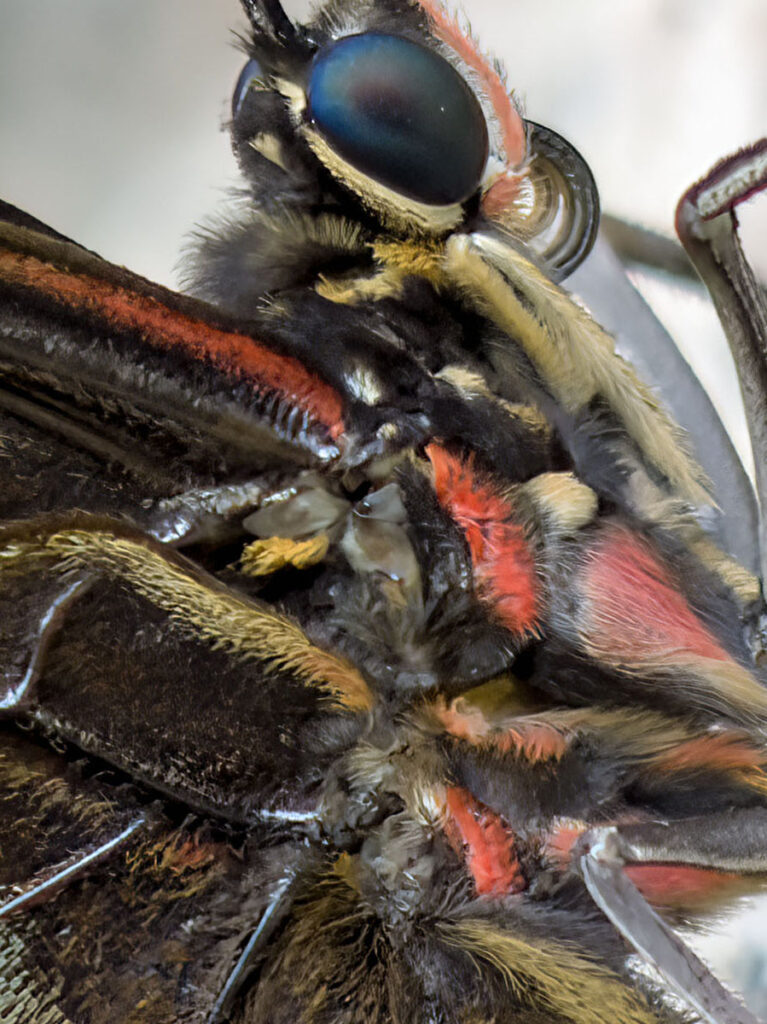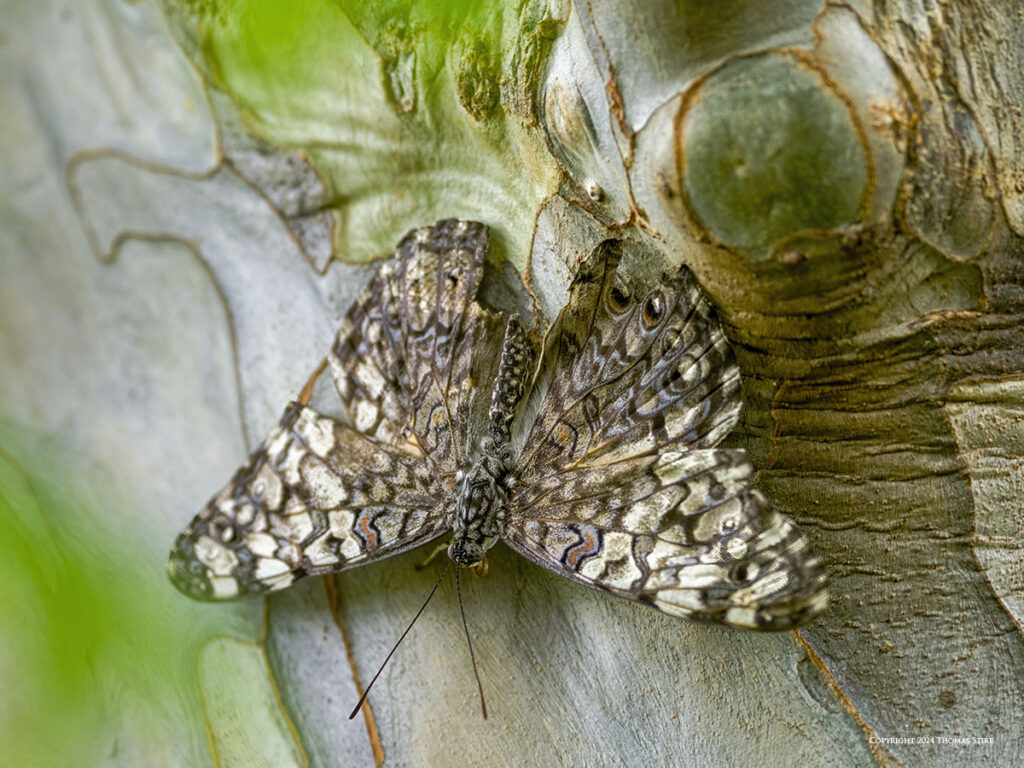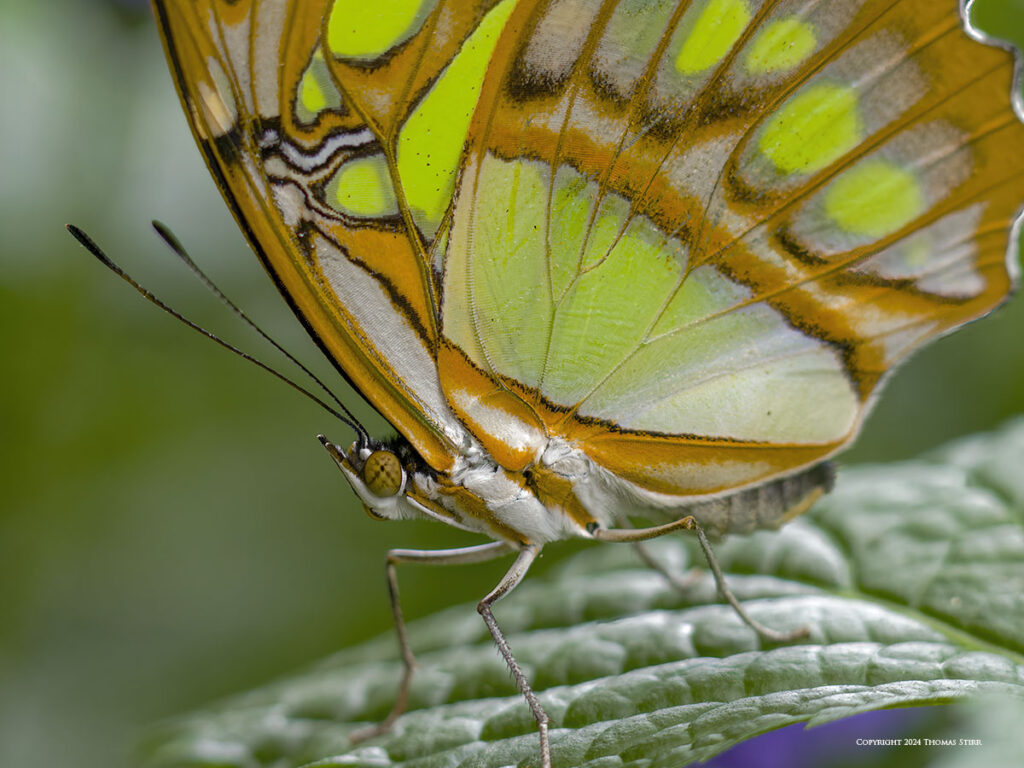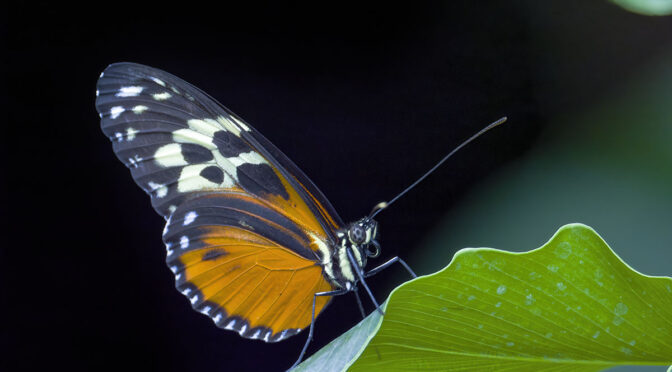This article discusses an HHHR (Handheld Hi Res) test with the M.Zuiko 150-600, and shares some handheld images captured at the Niagara Butterfly Conservatory.
My objective with this short test was simply to find out how well the Handheld Hi Res technology would work with the M.Zuiko 150-600 and its Sync-IS. All of the images featured in this article are full frame captures without any cropping… but resized for this website.
As regular readers know I’m not a pixel peeper. To me this is akin to looking at a painting brush stroke by brush stroke… but I added a few 100% crops for those folks who may be interested.
NOTE: Click on images to enlarge.


Incredible becomes the ‘new normal’.
As I was driving to the Niagara Butterfly Conservatory I was reminded of the tasks I was asking my camera and lens to do when deciding to photograph some butterflies and flowers with Handheld Hi Res technology.

By using Handheld Hi Res I was expecting my camera to take 16 separate images in rapid succession after just a single shutter release on my part. Sense any movements with my body and adjust IS for each image. Combine all of those 16 images in camera. Create a RAW file about 2.5 times larger than the native resolution of my E-M1X’s sensor. And, give me a RAW file with improved dynamic range, with less noise, than a standard resolution file.

I had to give my head a shake. Camera gear being able to do all of that is nothing short of incredible. Especially when I remembered back 5 years ago with my own photographic journey… when none of that technology existed for me. And… here I was calmly driving to Niagara Falls realizing that something incredible had become a ‘new normal’ for me.

It is easy for those of us who use OM/Olympus camera gear to forget how powerful and unique the computational photography technology resident in our cameras really is. Sometimes all of the noise and hype in the market place about other cameras that utilize larger format sensors is obfuscating.


My wife and I spent a little over an hour at the Niagara Butterfly Conservatory, which was sufficient time for me to capture all of the photographs featured in this article. During that time I was pleasantly surprised with what I was able to create with the new M.Zuiko 150-600 mm f/5-6.3 IS zoom and my trusty (soon to be 5 years old) E-M1X. I hadn’t anticipated how easy it would be to create these photographs.

When everything becomes fair game.
It only took me a couple of minutes to appreciate that everything in the Niagara Butterfly Conservatory had become fair game for my camera gear. If I found an upside down butterfly in shade… hiding under a leaf… no problem.

I could fully extend my M.Zuiko 150-600 mm f/5-6.3 IS to 600 mm (efov 1200 mm) to fill the frame of my composition from 3.6 metres away… and get a good HHHR capture with a shutter speed of 1/160.

From a distance of 1.2 metres away from a subject butterfly I could achieve shallow depth-of-field and get good subject separation in my images.

I could challenge my camera gear by putting a subject butterfly up against a windowed background in my composition… so that it looked almost black in my viewfinder. Then use Center Weighted Average metering to better balance the lighting, and take advantage of the increased dynamic range from HHHR in post.


I could photograph subject butterflies that were in dark areas of the conservatory, requiring the use of ISO-6400, and not having to give any thought to image noise.

I could photograph subjects at interesting angles and get pin point accuracy with my auto-focus my using a single, small AF point.


The incredible focal length range of the M.Zuiko 150-600, coupled with comparatively short minimum focusing distances, delivered a lot of compositional freedom. This was extremely helpful when trying to photograph butterflies in and around crowds of people at the facility.

The performance of the Sync-IS in my M.Zuiko 150-600 mm f/5-6.3 IS was superb. I was able to shoot at relatively slow shutter speeds and successfully capture all but one of my HHHR attempts. That one failed because another butterfly flew through my composition during an HHHR capture.

I could be lazy in post… and loved it!
The quality of my HHHR files was such that I could be lazy in post… and I loved it! I don’t think I can remember spending so little time on processing RAW files than the ones used to create the photos for this article.

Within the first 5 minutes of shooting at the Niagara Butterfly Conservatory I had total confidence that I would get successful HHHR image captures with any butterfly that I picked as a subject… as long as it remained motionless of course.

Throughout my visit to the Niagara Butterfly Conservatory I never felt that my M.Zuiko 150-600 mm f/5-6.3 IS was too big, or too heavy, to use effectively for this subject matter. It handled very well, with the ‘S’ push/pull focal length adjustment being a joy to use.

It was overcast and drizzly during our visit, so I didn’t bother trying to use the MC-14 or MC-20 as I didn’t feel I had enough light to do so. The Handheld Hi Res technology on my E-M1X is limited to a maximum of ISO-6400. So using teleconverters for more close up work is something for me to try in a future test.

Threading the needle.
The focal length range of the M.Zuiko 150-600 came in very handy when I had to shoot through small openings in trees/branches and past other types of foliage.

The image above is a good example of using the 600 mm (efov 1200 mm) reach of the M.Zuiko 150-600 to photograph past some leaves and branches. I really liked the potential for high contrast lighting in this composition. The trick was finding the right shooting angle to be able to put the butterfly’s wings up against very dark shade. Threading the needle through some foliage by using a 600 mm (efov 1200 mm) did the trick.


A few lessons learned.
While I often shoot my M.Zuiko lenses wide open, there are some situations where it may have been beneficial to stop the M.Zuiko 150-600 down a bit to produce deeper depth-of-field. The butterfly in the above image is a good example of where stopping down to f/8 or f/11 could have been helpful.

One has to pay a bit more attention to any movement of a butterfly’s proboscis when using Handheld Hi Res as some motion artifacts can be recorded on the image file. When using a macro lens it is obviously much easier to spot proboscis movement.

Summary
I found that the Handheld Hi Res (HHHR) technology resident in my E-M1X worked very well with the M.Zuiko 150-600 mm f/5-6.3 IS zoom.
The stability of the Sync-IS made capturing HHHR images with shutter speeds of 1/100 and higher quite easy to do… even at longer focal lengths.
The quality of the HHHR RAW files made post processing a breeze. I’m looking forward to doing additional testing with HHHR by incorporating teleconverters into the mix.

Technical Note
Photographs were captured handheld with the camera equipment noted in the EXIF data. All images were created from RAW using my standard process. All images were capturing using Handheld Hi Res technology. A single, small AF point was used for all of the photographs in this article. This is the 1,374 article published on this website since its original inception in 2015.
How you can help keep this site advertising free
My intent is to keep this photography blog advertising free. If you enjoyed this article and/or my website and would like to support my work, you can purchase an eBook, or make a donation through PayPal. Both are most appreciated.
Sometimes all we need as photographers is a bit of inspiration. We hope you can find some of that inside Finding Visual Expression II.
Finding Visual Expression II is available for download for an investment of $11.99 CDN. The best viewing experience of this eBook will be at 100% using Adobe Acrobat Reader.
You may be interested in all of the 30 concepts covered in both of these related eBooks. If so, you may want to also consider Finding Visual Expression.
Finding Visual Expression is available for download for an investment of $11.99 Cdn. The best viewing experience of this eBook will be at 100% using Adobe Acrobat Reader.
Our other eBooks include Images of Ireland, New Zealand Tip-to-Tip, Nikon 1: The Little Camera That Could, Desert & Mountain Memories, Images of Greece, Nova Scotia Photography Tour, and a business leadership parable… Balancing Eggs.
If you click on the Donate button below you will find that there are three donation options: $7.50, $10.00 and $20.00. All are in Canadian funds. Plus, you can choose a different amount if you want. You can also increase your donation amount to help offset our costs associated with accepting your donation through PayPal. An ongoing, monthly contribution to support our work can also be done through the PayPal Donate button below.
You can make your donation through your PayPal account, or by using a number of credit card options.
Word of mouth is the best form of endorsement. If you like our website please let your friends and associates know about our work. Linking to this site or to specific articles is allowed with proper acknowledgement. Reproducing articles, or any of the images contained in them, on another website or in any social media posting is a Copyright infringement.
Article and images are Copyright 2024 Thomas Stirr. All rights reserved. No use, duplication or adaptation of any kind is allowed without written consent. If you see this article reproduced anywhere else it is an unauthorized and illegal use. Posting comments on offending websites and calling out individuals who steal intellectual property is always appreciated!




Sorry, hard finding the answers you have posted to our questions sometimes. I wonder if there is a way to index our posts?
Hi Reno,
I know there is a lot of content on the website, and it can be challenging at times. We do have each article placed in various categories which can be helpful to find postings. These categories are listed on the right-hand side of the website. In the future if you think I’ve missed replying to you, just drop me a personal email and I’ll see if I can help.
Tom
What is your workflow that allows you to expose the subject distance? I’m having a hell of a time with my OM1; the only application that decodes and shows it is a version of exiftool newer than 2022.
Hi Ian,
My initial processing is done in DxO PhotoLab Version 7 for the new 150-600 (I’ve been using DxO as my main RAW processor for over a decade now). I do some really quick RAW processing then export a DNG file into an old copy of PhotoShop CS6. After that if I need to do any additional tweaks I use Topaz Noise AI, Topaz Sharpen AI, or the Nik Collection. I think DxO reveals the distance to subject estimates… although I can’t see it in that program.
After I finish processing images I store my files in Windows Explorer. When I right click on a finished jpeg I can access ‘Properties”. I can then left click on ‘Details’ and the Subject Distance is there to view. I’ve been doing this for the past 5 years with my Olympus/OM gear. It is really simple to access this information. Obviously a camera must have the ability to calculate estimated subject distance. None of my Nikon 1 camera bodies could do this, but my E-M1Xs and my wife’s E-M1 Mark III have this ability.
Hope this has helped.
Tom
Beautiful captures! It would be great to be able to view them full size and not resized to 1200×900, since being able to punch in would be the best way to assess the level of details achieved by HHHR. Alternatively, maybe you could add a few crops, even the same size as the pictures you included, but from full res pictures. I understand copyright concerns, but I’m sure there’s a way to do it with embedded viewer and zoom function.
Hi Konrad,
I’ve added five 100% crops to the article.
Tom
Thank you! Amazing detail on the banded orange spider! You can see crystals of nectar on its ‘trunk’!
Great results for an extreme telephoto lens!
Thanks Konrad… I’m glad you enjoyed the images!
Tom
Hah! Amazing photographs. Ain’t technology grand. I wish I was there to see the folks looking at you holding a gigantic lens and camera combo shooting butterflies! Probably saying something like “that guy ain’t not knowing nuthin bout taking pictures”! And then, they have NO idea of the technology in your hands, let alone being OLYMPUS!
Hi Randy,
I likely got a few strange looks… but I was more concerned about finding good butterfly subjects and shooting angles.
Tom
Dear Tom,
I figured no one deserved, or would get more out of, the new lens than yourself. Good job, your ability is humbling, and I am grateful for your articles.
But, did your wife take any pictures? I am thinking that her gear is humbler than yours, more like my own. And though I expect she is a better person than you, perhaps her photography skills are more human?
Regards, Mark
Hi Mark,
Yes, my wife is a much better person than I am. She uses an E-M1 Mark III along with an M.Zuiko 14-150 mm f/4-5.6 II, and an M.Zuiko 75-300 mm f/4.8-6.7 II. She is in the very early stages of doing some macro photography and used our M.Zuiko 60 mm f/2.8 macro. Everything about her is more human than me.
I’m glad are enjoying the articles.
Tom
I now have my 150-600 lens. What method of hand holding do you find works the best? Note, I have asked some questions in the past and found no answers. Let me know where I should look for these. I’ll stop buying you a coffee if I can’t get or find any answers.
Hi Reno,
Here is a link to an article that I wrote on this subject some time ago: https://smallsensorphotography.com/tips-on-photographing-hand-held
If I am waiting for a bird to take flight and need to hold my M.Zuiko 150-600 up for a longer period of time I will also move my left hand down closer to my camera body. This allows me to form a good, solid triangle by locking my left elbow into my body.
I do my best to reply to all comments from readers. Send me a personal email with any questions you think have been missed.
Tom